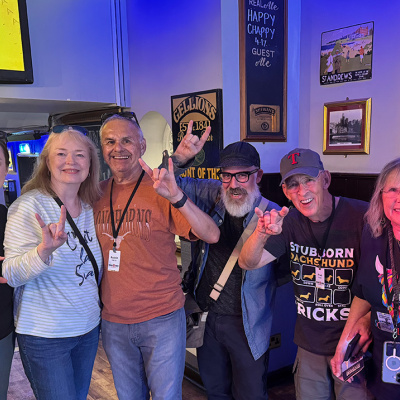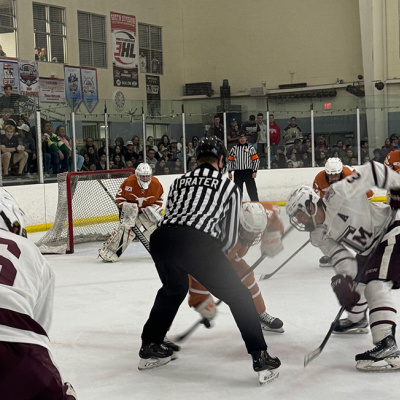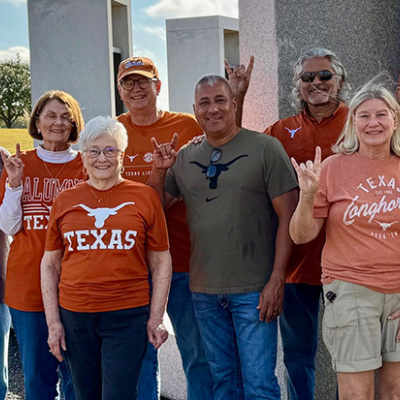Dinosaur in the Deep End

I was on the phone with paleontologist Wann Langston and about to hang up when he said, "Do you want to hear an interesting story?"
Back in 1936, The University of Texas put on an exposition in Gregory Gym as part of the state's centennial. It showcased the University's treasures, plus any other wonders the organizers could lay hands on from around the state. One of the most spectacular artifacts was a 67-foot limestone slab bearing the footprints of a three-toed dinosaur. It was so big the organizers erected a special wooden platform in front of the gymnasium for people to view it. Atop the tracks, they put a life-size papier-mâché dinosaur frozen in mid-stride as it squashed its way across a muddy tidal flat.
The show lasted from June to December, and then everything was disassembled. Soon after, the dinosaur tracks vanished.
"How do you lose a dinosaur?" asked Langston, now professor emeritus in the Jackson School of Geosciences. I visited with him several times to ask for more details or share some tidbit I'd learned digging in the University's libraries. Each time he posed the same question. Like him, I was bitten by the missing dino bug.
The late Glen Evans, a paleontologist at the University when the tracks went missing and one-time director of the Texas Memorial Museum, once told him the tracks were "in a swimming pool under a building on Little Campus." Over the years, Langston had never figured out exactly where that was, but it remained a tantalizing clue.
Although he never saw the tracks in person, Langston did have a connection to them. The man who made the dinosaur model for the centennial display was none other than his old mentor, J. Willis Stovall of the University of Oklahoma. Young Langston was a budding paleontologist. On weekends, he would go 18 miles from his Oklahoma City home to assist grad students in the fossil preparation lab in the OU geology building’s basement. He also sometimes went along on fossil-collecting trips.
As preparations for the centennial exposition got underway in 1936 and Langston was just beginning high school, UT contracted Stovall to make the dinosaur model for $200, including delivery to Austin. After the centennial, the model disappeared, too.
On the Case

I made calls and cornered old-timers in the halls. Most people I asked said, "You mean the dinosaur tracks next to the Memorial Museum?" No, I explained, those were collected four years later in a different county and contain the prints of two different types of dinosaurs.
"Oh,” they said. “Then I have no idea."
I poked around in the Walter Geology Library, the Briscoe Center for American History, and the Alexander Architecture Archives and gleaned a few details.
The tracks were discovered along Cowhouse Creek in Hamilton County, dug out in pieces by young paleontologist Bill Strain, shipped to Austin, and reassembled. At the time, it was thought to be the longest trail of dinosaur tracks ever exhibited. The three-toed, meat-eating monster that made them was estimated to be about 25 feet long with a five-foot stride.
After high school and completing an undergraduate degree at OU, Langston laid his own tracks far from home. He earned his doctorate at UC-Berkeley and curated vertebrate at the National Museum of Canada.
Then in 1962, he came to the Texas Memorial Museum. In the four decades since, he has researched the dinosaurs, pterosaurs, and crocodilians of the Big Bend region of Texas.
He gave little thought to the missing dinosaur tracks until the late 1980s, when he ran across photos of Stovall’s dinosaur model in the University's archives. He asked a few elders around UT if they knew anything about what happened to the tracks, but the closest he got was the swimming pool reference from Glen Evans.
"I wouldn't say they're my number-one priority," the 90-year-old Langston says of the missing tracks. "I just happened to be the only one around here to have lived long enough to remember this episode."
Last Stop: Little Campus
An article in the Daily Texan from Dec. 3, 1936 describes the clearing out of Gregory Gym in preparation for basketball season and student dances. It described where many of the wonders from the centennial exposition were going to go: Indian mannequins, stuffed buffalo and wild turkeys, rare books and documents, guns, saddles, and relics were heading to the Littlefield Home, the Old Library Building attic, the Biological Laboratory, and elsewhere.
"The dinosaur tracks, one of the largest exhibits," the Texan said, "will be removed sometime next week and stored in Little Campus Dormitory."
Little Campus was a block next to the southeast corner of the main campus that was home to student dorms and various offices and labs, including the Bureau of Economic Geology. The head of the Bureau, Elias Sellards, directed the soon-to-open Texas Memorial Museum. Many of the university's fossils were already housed near Sellards' office on Little Campus.
So the Little Campus part of the legend made sense. But what about the "swimming pool under a building"?
I assumed the legend meant there was once an outdoor pool on campus that was built over. I checked campus maps, but couldn't find a pool that had been built over. And no new buildings were built on Little Campus after 1936.
Then, reading through a history of Little Campus titled Remnant of an Era, I found what I was looking for. In the book, Steven L. Tillotson wrote that the Building G dormitory had a swimming pool built into the first floor. Suddenly the legend made more sense.
I couldn't locate anyone who had worked in that building in 1936, when the tracks were relocated, or even for many years after. Alan Thompson, former director of the University's evening classes, worked on the third floor of Building G from the early to mid '70s. He didn't remember a pool. Perhaps it had been sealed up or walled off by then.
A 1986 article in The Alcalde noted that archaeological artifacts had at one time been stored in "the swimming pool under the Little Campus Building" until they were moved out to what is now the Pickle Research Campus. Clearly, it was used to store items that people just didn't have room for.
The Dinosaur One Step

Today, what's left of Little Campus has been renamed the Heman Sweatt Campus. Some of it was carved up for an expansion of I-35 and rerouting of Red River Street, while some went toward an Erwin Center parking lot. Most of the buildings were abandoned and torn down. Only two structures remain on the now even littler campus: John W. Hargis Hall (originally Building H), which was the Bureau's main building in the 1930s, and Custer House (originally Building C), the headquarters of General Custer for three months following the Civil War. Building G, which housed the swimming pool, was torn down in the late 1970s. It's now an empty patch between the two remaining buildings.
I called to tell Langston that I had pinpointed the location of the swimming pool. But he had a surprise for me. He said one of the original dinosaur footprints had actually survived. It had been around the Vertebrate Paleontology Lab, where he works, for decades. Now it was on display at the Texas Memorial Museum.
Excited, I went to visit with the museum's exhibit designer, John Maisano, and sure enough, there it was in the Cretaceous display among dinosaur skulls and assorted bones. The imprint itself was painted orange to show up against the surrounding rock. The catalog number painted on its side indicated it was from the same dig site in Hamilton County as the 1936 trackway. Langston is confident this footprint is indeed from the same trackway that was displayed.
But what of the other 16 tracks? Were they left in the pool when the building was torn down? Were they moved somewhere else long before? And were they intentionally discarded or was there some kind of accident?
A Different Time
Today there's a whole branch of science—ichnology—devoted to studying the tracks, scratches, burrows, and other signs left behind by animals. It's thrown open a picture window on what life was like in the distant past.
"It finally dawned on people that tracks were the closest thing to a living animal that we're ever going to have, because the tracks represented things the living animal actually did," said Langston. "There are a lot of ichnologists around now, but it was just getting started around that time."
I asked Langston what was lost to science when the tracks disappeared. He said there's no way to know. No one at UT in the 1930s had the expertise to thoroughly study them; he doubted they were examined much beyond basic measurements. Many of the items in the centennial exposition, he said, were chosen because they were unusual or striking, not for their scientific value or representation of the state’s natural history.
Whatever happened to UT's first dinosaur tracks, the University isn't alone. Paleontologists from OU found their own dinosaur trackway in the Oklahoma Panhandle around the same time and brought it home for display. The tracks were set in a concrete slab for a walkway on the university campus.
"We know what happened to them," said Langston. "They broke up and people threw them away. They just didn't stand up to human foot traffic after 120 million years."
Most of The University of Texas' first dinosaur tracks and whatever insights they might have yielded for scientists might never be recovered, but the final chapter of their story is yet to be written. Are there any amateur sleuths out there? Were you here in 1936 and do you remember seeing the tracks? If you’ve got a theory, a photo, or better yet, some rock-solid evidence about what happened to UT’s missing dinosaur tracks, drop Jackson School writer and science sleth Marc Airhart a line at mairhart@jsg.utexas.edu.
Special thanks to: Catherine Best, Matt Brown, Wann Langston, John Maisano, Pamela Owen, Nancy Sparrow, Alan Thompson, and Dennis Trombatore.





